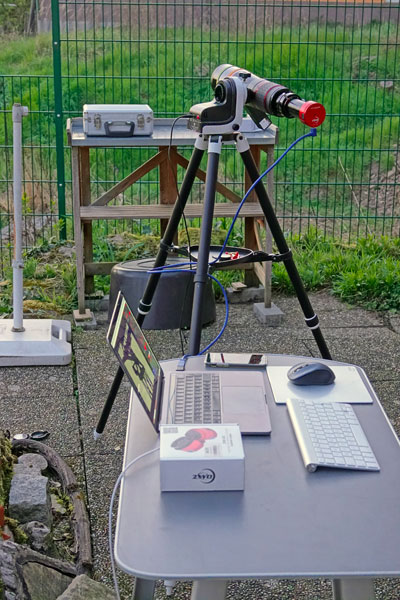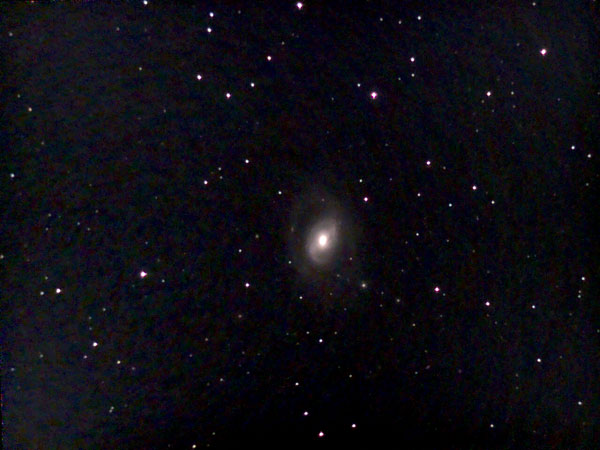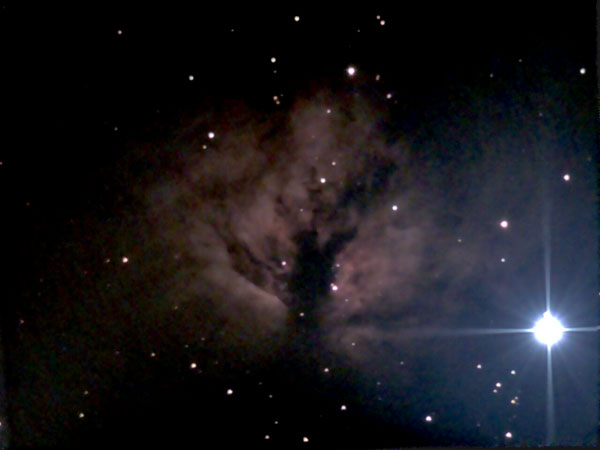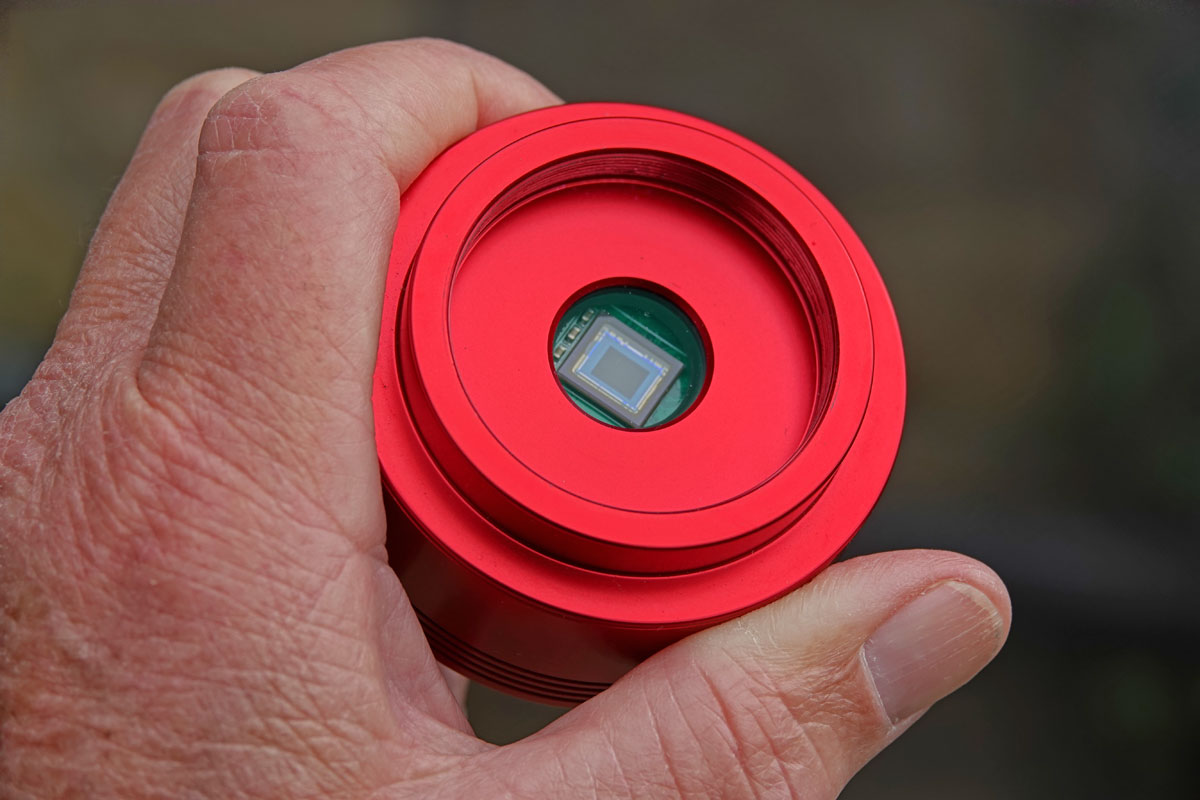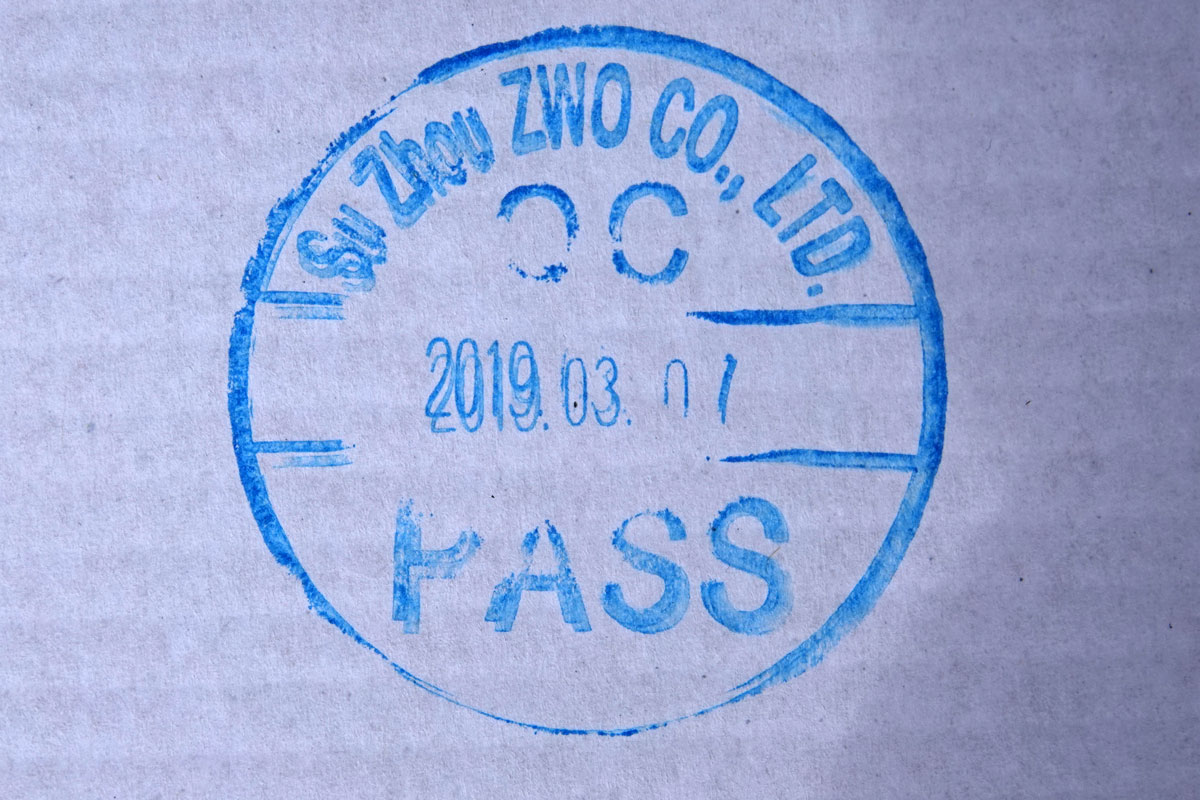ZWO ASI224 Color Camera - Information
Look | Look of the Camera at the PS 72/432 | Sensor, Pixel Data, Field of View | Visited Sky Objects | First Photo Attempts | Telescope Comparison | Quick-and-Dirty Comparison with the Original eVscope | Preliminary Conclusions | Links | Appendix: Data
Archive
On this page, I present some information about my ZWO ASI224MC color camera (borrowed from a starfriend at the beginning of April 2021, bought on April 25, 2021; sold in April 2022). This camera has the same Sony sensor as my Unistellar eVscope (Sony IMX224/225), so I was interested in finding out how it would perform on my telescopes in comparison with the eVscope and my Atik Infinity camera.
See the appendix for the data. So also pages:
- ZWO ASI224 Color Camera - Information Archive
- ZWO ASI224 Color Camera - First Experiences Archive
- ZWO ASI224 Color Camera - Further Experiences Archive
- ZWO ASI 224 versus eVscope - Photo Comparison Archive
- ZWO ASI224 - Photo Gallery Archive
- ZWO ASI294 Color Camera - Information Archive
- ZWO ASI462 Color Camera - Information Archive
| Note: I bought a ZWO ASI294MC camera in the beginning of April 2022 in order to get more resolution and field of view, and I thus, sold my ZWO ASI224MC camera in mid-April 2022. I therefore can no longer report any further experiences with this camera here. |
Look
Unboxing...
Note: Since this is a used camera, the package may not be in its original state...

Box and camera cable (not original) |

Box opened (center and right) The stamp shows the date 2019.03.07 (center) | |
 |
 |
Box opened and (nearly) emptied |
Look of the Camera |
||
 |
 |
 |
 |
 |
 |
 |
 |
 |
Look of the Camera at the PS 72/432
 |
 |
 |
 |
 |
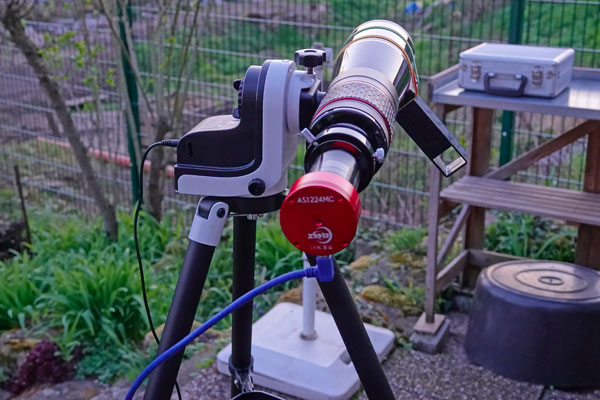 |
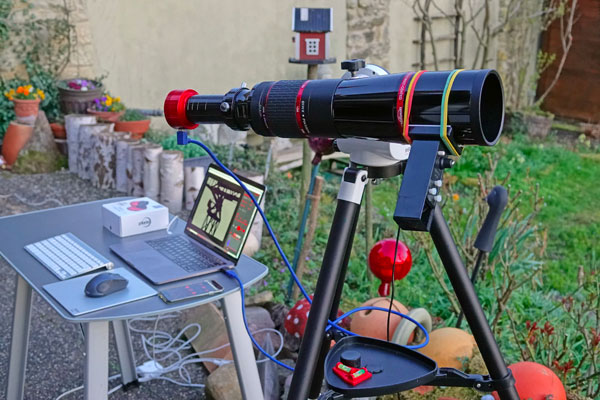 |
 |
 |
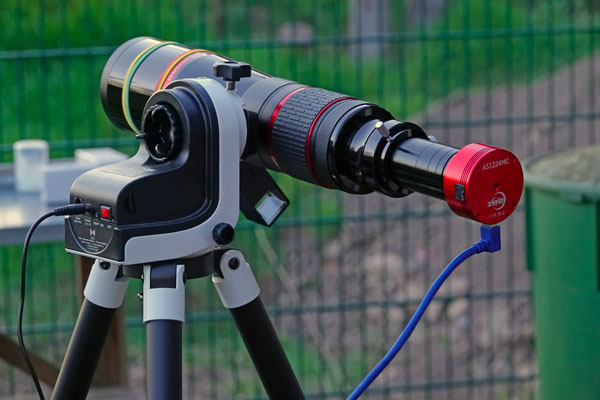 |
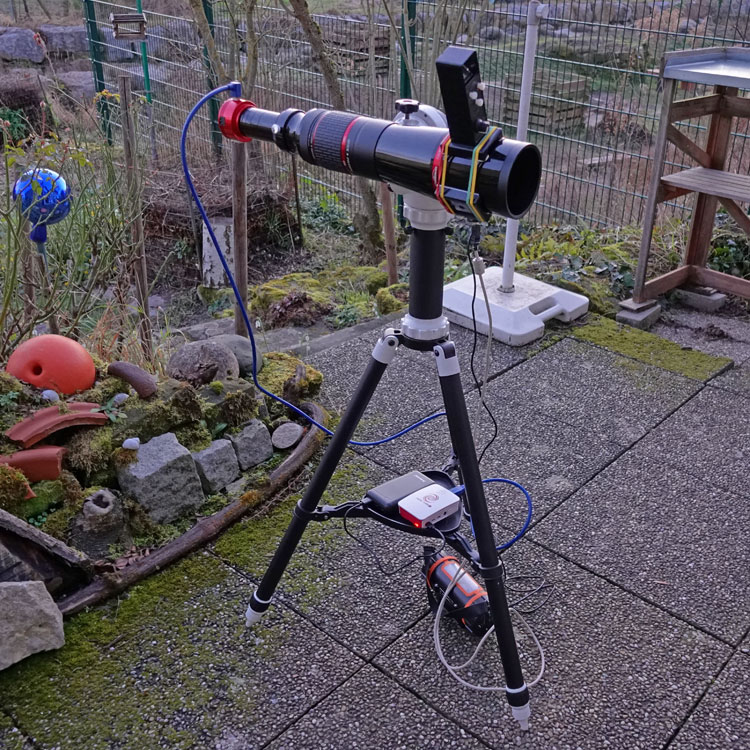 |
Most photos show the camera with equipment that uses the SynScan app for the mount control and laptop software for taking stacked images. The photo at the bottom right shows the "StellarMate" equipment, where the StellarMate is controlled jusing the StellarMate app on my iPad. I also added a second finder shoe so that the Rigel finder is in a comfortable position.
Sensor, Pixel Data, Field of View
The ASI224MC camera uses the same Sony sensor type as my eVscope, namely the Sony IMX224/225 (CMOS), with a resolution of 1.2 MegaPixels, or 1304 x 976 pixels (H/V; the eVscope uses a resolution of 1280 x 960 pixels). The pixel size is 3.75 µm (quadratic pixels). With this, all sizes are known to calculate the field of view of the camera at different telescope tubes!
For simplity reasons, I did not calculate the values myself, but used the Website astronomy.tools for calculating the field of view of the ASI224MC camera at my current telescope tubes (as of April 2021):
Legend: Orange Custom Scope = eVscope; Red Custom Scope = PS 72/432
And here the same for the Atik Infinity camera for comparison (nearly twice the FOV of the ASI224):
Legend: Orange Custom Scope = eVscope; Yellow Custom Scope = PS 72/432
I summarize the results of both diagrams (and further ones) in the following table:
Field of View |
|||||||||
| Telescope | Reducer | Focal Length |
Aperture | f | ASI224MC* | ASI294MC* | ASI462MC* | Atik Infinity* | Remarks |
| PS 72/432 | --- | 432 | 72 | 6 | 0.65° x 0.48° | 2.54° x 1.73° | 0.74° x 0.42° | 1.19° x 0.89° | The largest FOV of my tubes |
| C5 | --- | 1250 | 127 | 10 | 0.22° x 0.17° | 0.88° x 0.60° | 0.26° x 0.15° | 0.41° x 0.31° | FOV like C8 with reducer |
| C5 | f/6.3 | 787.5 | 127 | 6.3 | 0.36° x 0.17° | 1.40° x 0.95° | 0.41° x 0.23° | 0.65° x 0.49° | FOV a little smaller as with TLAPO1027 |
| C8* | --- | 2032 | 203 | 10 | 0.14° x 0.1° | 0.54° x 0.37° | 0.16° x 0.09° | 0.25° x 0.19° | The smallest FOV |
| C8* | f/6.3 | 1280 | 203 | 6.3 | 0.22° x 0.16° | 0.86° x 0.58° | 0.25° x 0.14° | 0.4° x 0.3° | FOV like C5 |
| TLAPO1027* | --- | 714 | 102 | 7 | 0.39° x 0.29° | 1.54° x 1.05° | 0.45° x 0.26° | 0.72° x 0.54° | FOV a little larger than for C5 with reducer |
| in Degrees | in Minutes | ||||||||
| eVscope* | --- | 450 | 114 | 4 | 0.61° x 0.46 | 36.7' x 27.6' | Same sensor as ASI224: Sony IMX224 | ||
| eVscope 2* | --- | 450 | 114 | 4 | 0.78° x 0.57°* | 47' x 34' | *New sensor: Sony IMX347 | ||
| Vespera* | 200 | 50 | 4 | 1.6° x 0.9°** | 100' x 54' (ca.) | **Same sensor as ASI462: Sony IMX462 | |||
| Vespera Pro | 250 | 50 | 5 | 1.6° x 1.6° | 100' x 100' (ca.) | New sensor: Sony IMX676 | |||
*) No longer in my possession
Roughly simplified, the fields of view of the Atik Infinity are almost twice as large per dimension, that is, the image areas are almost four times as large as those of the ASI224MC. Since the chips use roughly the same numbers of pixels, this difference is mainly due to the different pixel sizes (3.75 versus 6.45 µm).
Visited Sky Objects
At the beginning, I visited (and documented...) the following sky objects with the ZWO ASI224MC and with my telescopes PS 72/432, C5, and TLAPO1027:
- M 11, M 13, M 16, M 17 , M 20, M 27, M 42/43, M 51, M 57, M 65, M 66, M 71, M 78, M 92, M 95, M 96, M 105, NGC 2024, NGC 3628, NGC 6041, NGC 7317
See page My Deep Sky Observations with the Atik Infinity (Complete List of Observed DSO) for more information.
First Photo Attempts
April 8, 2021: Night Test with PS 72/432 Refractor
On April 8, 2021, I tried the ASI224MC camera for the first time at night. So the camera had its "first light", namely at my PS 72/432 refractor on the AZ-GTi mount (controlled via iPhone with the SynScan app). I used the camera software ASILive, because this also runs on the Apple Macintosh under OS X and because it is easier to use than SharpCap. Moreover, the latter can only be operated under Windows (on the Mac with emulator). I did not use dark frames, so hot pixels and amp glow were more or less visible.
I started my session with the Orion Nebula M 42/43 before supper, tracked the nebula for about 20 minutes during supper (it was still in the eyepiece after that, but no longer at the center), and then continued with the Orion Nebula once more. Further targets were the Flame Nebula NGC 2024 (found via Alnitak), M 78, and finally M 96, where I actually wanted to photograph M 105, missed it, and after some searching finally found M 96 - and stayed there.

M 42/43 (16 frames, 10 s, gain 134) |
 M 42/43 (21 frames, 10 s, gain 134) |
 NGC 2024 (30 frames, 10 s, gain 300) |
 M 78 (30 frames, 10 s, gain 300) |
 M 96 (30 frames, 10 s, gain 300) |
Overall, the results were not convincing, but I was glad to have found and photographed something at all with the unfamiliar camera and camera software! In the end, I first had to learn how to control the camera with ASILive. This involved setting the exposure time, the gain (amplification = ISO), handling the brightness control for the image, and last but not least saving the photos. Not all questions have been answered on that evening!
April 13, 2021: Another Re-Test with C5 and PS 72/432
On April 13, 2021, I tested the ASI224MC camera for the third time at night (I skip the second test here, because I took no photos), at the C5 with f/6.3 reducer/corrector and at my PS 72/432 refractor, both on the AZ-GTi mount (controlled via iPhone with the SynScan app). Again, I used ASILive as camera software. And once again, I did not use dark frames because I still did not know how to create them in ASILive.
With the C5, I was not able to take usable photos (M 42/43, M 78) because the stacking aborted nearly immediately. With the PS 72/432, things went better, and I was able to observe and photograph the following objects: M 65/66, NGC 3628, M 105, M 95, M 96, and M 51. The stars were a bit blown up once again...
Here are two versions of M 51 at different gains:
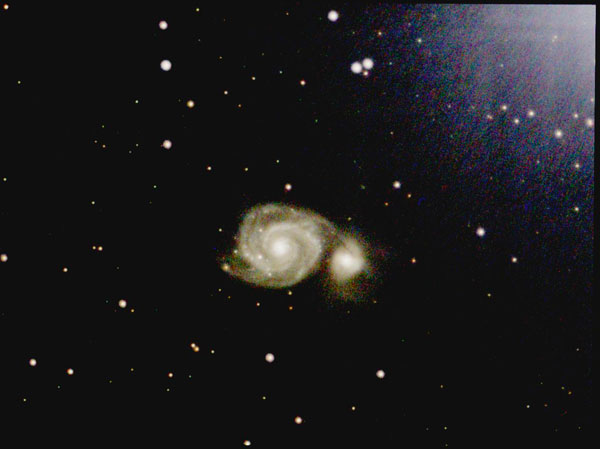
M 51 (76 frames, 10 s, gain 300) |

M 51 (50 frames, 10 s, gain 134) |
Further "Dry Runs" and Night Tests
I describe further "dry runs" and night tests on pages ZWO ASI224 Color Camera - First Experiences and ZWO ASI224 Color Camera - Further Experiences in order to keep this page fairly short...
Telescope Comparison
Below, I present a comparison from page ZWO ASI224 Color Camera - Further Experiences between three telescopes using the ASI224 camera:
Read my brief conclusions on this on page ZWO ASI224 Color Camera - Further Experiences!
Quick-and-Dirty Comparison with the Original eVscope
One reason to look into the ZWO ASI224MC was that this camera uses the same sensor chip Sony IMX224/5 as the original eVscope (albeit in a slightly different mode). In this respect, it appealed to me to make a comparison between the eVscope and the ASI224MC, especially since I was not really satisfied with the initial image quality of the eVscope: The photos looked too much like "brushed" for my taste and showed too few details. Photo comparisons of other amateur astronomers confirmed this. Over time, Unistellar kept making changes to the eVscope's image processing that were more or less noticeable. Finally, with the app version 1.3, a more comprehensive change was made, in which on the one hand the image format was enlarged, but on the other hand (not only) improvements were made in the details as well. I made before-after comparisons of eVscope photos, which clearly demonstrate the improvements. However, it also showed that I was able to change older photos towards the new state - you just have to know which "screws" to turn.
In the following I would like to present a selection of DSO photos, which were taken with both the ASI224MC (with the PS 72/432 refractor) and the eVscope. Where possible, I use photos taken with the "new" image processing on the eVscope, but scale them down to 1280 pixels wide for an easier comparison with the ASI224 photos.
At first glance, the eVscope photos look much better. However, if you look more closely, the eVscope photos often look far too contrasty and trimmed for "effect". I also had little experience with editing photos in ASILive (or SharpCap). I think that with a little more effort and knowledge, photos equivalent in quality to the eVscope photos can be created with the ASI224MC.
What is noticeable in the ASI224 photos, is the stronger amplifier glow. This is partly because I did not take any dark frames with it, and partly because the new image processing of the eVscope produces a considerably darker sky compared to the old processing - and thus also reduces amplifier glow.
Preliminary Conclusions
For my experiences with the ZWO ASI224, see the subsequent pages ZWO ASI224 Color Camera - First Experiences and ZWO ASI224 Color Camera - Further Experiences. All in all, my results with the ZWO ASI224MC seem qualitatively inferior to those of the eVscope, but I think with sufficient experience in using ASILive and SharpCap this difference can be compensated for.
Note: Since April 2016, ZWO provides all ASI224MC and AISI224MC-C cameras with the PCB revision 1.3, which reduces amp glow. Inside the camera box there is a stamp with the year 2019 (I cannot decipher the Chinese date...), so the camera should already have the latest PCB. However, my first impression was that some of my shots exhibit a considerable amp glow.
Software: As an open question remains whether I will use the camera with ZWO free ASILive software or with the renowned application SharpCap... Alternatively, I tried to run the camera on the StellarMate astronomy computer, but I was not really able to get the latter to work (as of April 2022).
Update (as of October 2021): After acquiring a StellarMate astronomy computer, I used the ZWO ASI224MC alongside the Atik Infinity to try out the StellarMate and get it "working". However, by early April 2022, still no satisfactory results had materialized... Entry page to the StellarMate: Ikarus StellarMate Plus - Information
Update (April 7, 2022): After buying a ZWO ASI294MC at the beginning of April 2022 with a four times larger field of view (one dimension) and a higher resolution, I offered the ASI224MC for sale (see Selling Notes).
Update (April 13, 2022): ASI224MC sold.
| Note: I bought a ZWO ASI294MC camera in the beginning of April 2022 in order to get more resolution and field of view, and I thus, sold my ZWO ASI224MC camera in mid-April 2022. I therefore can no longer report any further experiences with this camera here. |
Selling Notes (Camera Sold)
I took the following photos for the purpose of selling my ZWO ASI224MC (April 7, 2022).
The equipment is no longer in its original state. I am probably the third owner of the camera and do not have any invoices. According to the ZWO stamp, the camera was produced in March 2019. The equipment corresponds, except for one item (missing ST4 cable*), to the condition as I first borrowed and then purchased the camera from a star friend in April 2021.
*) I sold the camera together with the cable.
Accessory Changes
- Missing: ST4 cable* (I need it for another camera whereit was missing) >> eventually, I sold the ST4 cable as well...
- Changed: the USB3 cable is not the original one (it is thicker and stiffer; I bough the camera together with this cable)
- Added: UV/IR cut filter for putting inside the camera; I never used this filter, because I bought a Baader UV/IR filter with a 1.25" thread, that can be used at other cameras as well.
Links
- ASI224MC (color) (ZWO Website): astronomy-imaging-camera.com/product/asi224mc
- See also my page offering Astronomy Links.
Appendix: Data of the ZWO ASI 224MC
Camera Technical Details (from ZWO Website)
- Sensor: 1/3" CMOS IMX224/IMX225
- Resolution: 1.2 Mega Pixels 1304 x 976
- Pixel Size: 3.75 µm
- Sensor Size: 4.8 mm x 3.6 mm
- Diagonal: 6.09 mm
- Read noise: 0.75 e- to 1.5 e- (0.8 e-)
- Full Well Capacity: 19,200 e-
- Exposure Range: 32 µs to 1000 s
- ROI: Supported
- Binning: 2 × 2 binning supported
- Focus Distance to Sensor: 12.5 mm
- Shutter Type: Rolling Shutter
- Protect Window: AR coated window
- Operating System Compatibility: Mac, Windows, Linux
- Interface: USB3.0/USB2.0
- Bit Rate: 12 bit output (12 bit ADC)
- Telescope Adaptor: 2" / 1.25" / M42 x 0.75 (T2)
- Diameter: 62 mm
- Weight: 100g
Since April 2016, ZWO provides all ASI224MC and AISI224MC-C cameras with the PCB revision 1.3, which reduces amp glow.
| 31.12.2025 |

